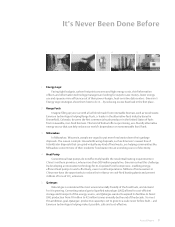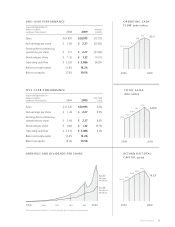Emerson 2009 Annual Report Download - page 19
Download and view the complete annual report
Please find page 19 of the 2009 Emerson annual report below. You can navigate through the pages in the report by either clicking on the pages listed below, or by using the keyword search tool below to find specific information within the annual report.
Annual Report 17
inbound power, uninterruptible power supply, precision
cooling and embedded power businesses due to the
continued slowdown in customers’ capital spending,
partially offset by growth in the China network power
systems business. Underlying sales declined 11 percent,
foreign currency translation had a 3 percent ($191 million)
unfavorable impact and a decline in sales for the
Embedding Computing acquisition had a 1 percent
($101 million) unfavorable impact. The underlying sales
decrease reects a 10 percent decline in volume and a
1 percent impact from lower selling prices. Geographi-
cally, underlying sales reect decreases in the United
States (19 percent), Europe (22 percent) and Latin
America (3 percent), which were partially offset by
increases in Asia (1 percent), as the Company continues
to penetrate the Chinese market, Canada (9 percent),
and Middle East/Africa (6 percent). Earnings decreased
29 percent to $567 million, compared with $794 million
in 2008, primarily due to lower sales volume and higher
rationalization costs of $90 million (particularly for the
integration of Embedded Computing), partially offset
by solid earnings growth for the energy systems and
China network power businesses. The segment margin
decrease reects deleverage on lower sales volume and
a negative impact from acquisitions, partially offset by
savings from cost reduction actions which contributed
to margin improvement for both the energy systems and
China network power systems businesses. Materials cost
containment was partially offset by lower selling prices
and increased wage costs.
Sales in the Network Power segment
increased 23 percent to $6.3 billion in 2008 compared
with $5.2 billion in 2007. The increase in sales reects
continued growth in the precision cooling, global
services, uninterruptible power supply, inbound power
and power systems businesses. Underlying sales grew
11 percent, while the Embedded Computing and Stratos
acquisitions contributed approximately 9 percent
($449 million) and foreign currency translation had a 3
percent ($156 million) favorable impact. The underlying
sales increase of 11 percent reects higher volume, which
includes an approximate 4 percent impact from penetra-
tion gains. Geographically, underlying sales reect a
17 percent increase in Asia, an 8 percent increase in the
United States, a 14 percent increase in Latin America, a
55 percent increase in Middle East/Africa and a 2 percent
increase in Europe. The U.S. growth reects continued
demand for data room construction, non-residential
computer equipment and telecommunications power.
Internationally, the Company continues to penetrate
the Chinese, Indian and other Asian markets. Earnings
increased 23 percent, or $149 million, to $794 million,
compared with $645 million in 2007, primarily due to
higher sales volume and savings from cost reduction
actions. The margin increase reects these savings and
leverage on the higher volume, partially offset by a
nearly 1 percentage point dilution from the Embedded
Computing acquisition and higher wage costs.
C h A n G e c h a n g e
(d o l l A R s in m i l l i o n s ) 2007 2008 2009 ‘07-‘08 ‘08 - ‘09
Sales $3,614 3,822 6%
Earnings $ 538 551 2%
Margin 14.9% 14.4%
Climate Technologies reported sales of
$3.2 billion for 2009, a 16 percent decrease from 2008,
reecting declines across all businesses, especially for
compressors, temperature sensors and heater controls.
Underlying sales decreased approximately 15 percent,
foreign currency translation had a 2 percent ($92 million)
unfavorable impact and acquisitions added 1 percent
($38 million). The underlying sales decrease reects
an approximate 17 percent decline from lower volume
and an estimated 2 percent positive impact from higher
selling prices. Sales declines in the compressor business
reect the worldwide slowdown in air-conditioning and
refrigeration markets, particularly in the United States
and Asia. The underlying sales decrease reects a
15 percent decrease in both the United States and inter-
nationally, including declines of 18 percent in Asia,
10 percent in Europe and 15 percent in Latin America.
Earnings decreased 28 percent to $397 million compared
with $551 million in 2008, primarily due to lower sales
volume, higher rationalization costs of $26 million, a
$15 million commercial litigation charge and a
$12 million negative impact from foreign currency
transactions related to the strengthening of the U.S.
dollar in 2009 versus weakening in the prior year, partially
offset by savings from cost reduction actions. The margin
decrease reects deleverage on lower sales volume
(approximately 2 points), as well as higher materials
costs, which were only partially offset by price increases.
Climate Technologies reported sales of
$3.8 billion for 2008, representing a 6 percent increase
over 2007, as underlying sales increased approximately
3 percent and foreign currency translation had a
3 percent ($110 million) favorable impact. The underlying
sales increase of 3 percent reects an approximate
2 percent positive contribution from price increases and
an approximate 1 percent gain from higher volume,
which includes a 2 percent impact from penetration
gains. The underlying sales increase was led by the
water-heater controls business, which primarily reects
penetration in the U.S. water-heater market. The
compressors business grew modestly, primarily in the
refrigeration and the U.S. and Asian air-conditioning
























